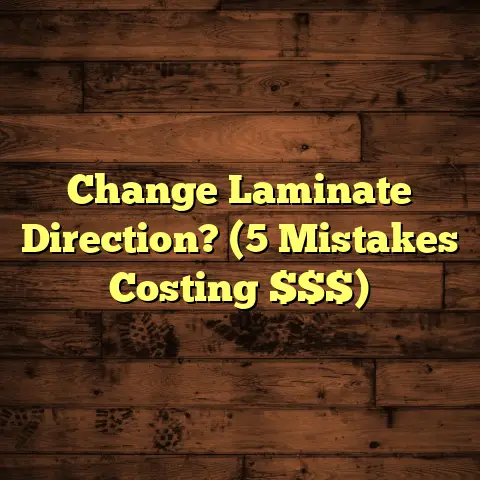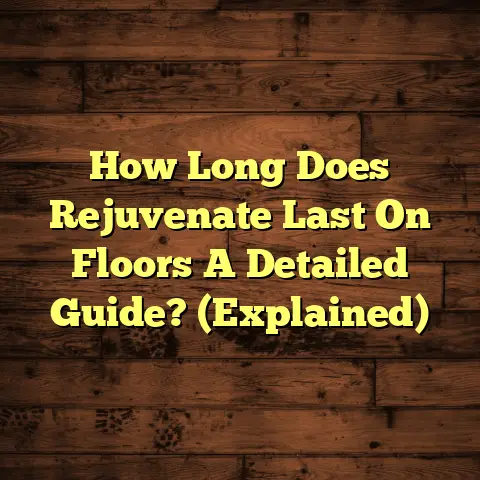Wet Garage Floor When It Rains? (4 Causes ASAP!)
They’re becoming legit extensions of our homes, right?
Think about it: epoxy floors, organized tool racks, maybe even a mini-fridge for those DIY projects.
But with all this focus on making our garages look good, we sometimes overlook the basics.
And one of the most annoying problems? A wet garage floor after it rains.
Trust me, I’ve seen it all. From minor puddles to full-on indoor swimming pools.
It’s not just a nuisance; it can mess with your stuff, damage your foundation, and even lead to mold.
In this article, I’m gonna break down the four main reasons why your garage floor might be getting wet.
We’ll cover everything from faulty drainage to sneaky groundwater seepage. Let’s dive in!
Section 1: Understanding the Problem of Wet Garage Floors
Defining the Issue
Okay, so what exactly does “wet garage floor” mean?
It’s pretty straightforward, but let’s be clear: it’s any situation where water is accumulating on your garage floor when it shouldn’t be.
This could be a small puddle after a light drizzle or a widespread flood after a heavy downpour.
Now, you might be thinking, “So what? I’ll just mop it up.”
But here’s the deal: repeated water exposure can cause some serious problems.
Think about it: rust on your tools, warping of stored items, and even structural damage to the concrete itself.
According to the American Society of Civil Engineers, water damage is a leading cause of building deterioration.
I’ve personally seen garages where the constant moisture has led to cracked foundations and crumbling walls.
It’s not pretty, and it’s definitely not cheap to fix.
Identifying Symptoms
So, how do you know if you’ve got a wet garage floor problem?
It’s not always as obvious as a giant puddle. Here are some telltale signs:
Pooling Water: This is the most obvious one.
Any standing water after rain is a red flag.-
Dampness: Even if there’s no standing water, the floor might feel damp to the touch.
-
Mold Growth: Keep an eye out for dark spots or fuzzy growth, especially in corners or along walls.
-
Musty Odor: That distinctive “wet basement” smell? That’s a sign of moisture buildup.
-
Efflorescence: This is a white, powdery deposit on the concrete surface, caused by water dissolving salts and bringing them to the surface.
I had one client who ignored a slight musty smell in his garage for months.
Turns out, he had a hidden leak that had caused significant mold growth behind some storage shelves.
By the time he called me, the remediation costs were through the roof!
Don’t make the same mistake.
If you notice any of these symptoms,
it’s time to investigate.
Section 2: Cause #1 – Inadequate Drainage Systems
Explanation of Drainage Systems
Alright, let’s talk drainage.
Your garage should have some kind
of system to handle water runoff, right?
The most common types are:
-
Floor Drains: These are drains installed directly in the garage floor, usually connected to the sewer system or a dry well.
-
Sloped Floors: The floor is slightly sloped towards the garage door, allowing water to naturally flow out.
-
Perimeter Drains: These are drains installed around the perimeter of the garage foundation to collect groundwater.
Ideally, you’d have a combination of these, but even one well-designed system can make a huge difference.
Think of it like this: your garage is like a boat.
If there’s a hole in the hull, you need a way to pump the water out, otherwise, you’re gonna sink!
How Drainage Failure Leads to Wet Floors
So, what happens when these drainage systems fail? Well, that’s when the problems start.
Here are a few common scenarios:
-
Improper Installation: If the floor isn’t sloped correctly, water will just pool in low spots.
-
Blockages: Drains can get clogged with leaves, dirt, and debris, preventing water from flowing through.
-
Design Flaws: Sometimes, the drainage system is simply inadequate for the amount of rainfall in your area.
I once worked on a garage where the floor drain was actually higher than the surrounding floor!
Needless to say, it wasn’t doing much to keep the water out.
The homeowner had to spend a fortune regrading the floor and installing a new drainage system.
Real-Life Examples
Let me share a couple of stories from my experience:
-
The Clogged Drain: I got a call from a homeowner who was freaking out because his garage was flooded after a heavy storm.
Turns out, his floor drain was completely blocked with leaves and dirt.
A quick cleaning solved the problem, but it could have been avoided with regular maintenance.
-
The Upside-Down Slope: Another client had a brand-new garage built, but the floor was actually sloped towards the back wall!
Every time it rained, water would flow into the garage and pool against the foundation.
The builder had to come back and completely redo the floor.
The moral of the story?
Make sure
your drainage system is properly
installed and maintained.
It’ll save
you a lot of headaches (and money)
in the long run.
Section 3: Cause #2 – Groundwater Seepage
Understanding Groundwater Dynamics
Okay, let’s talk about something a little less obvious: groundwater.
Even if your garage has a perfect drainage system, you can still get water intrusion from below.
Here’s how it works: when it rains, water soaks into the ground.
The water table (the upper level of underground water) rises.
If your garage floor is below the water table, or if there are cracks in your foundation, water can seep into your garage through capillary action.
Think of it like a sponge: the concrete absorbs the water like a sponge soaking up spilled juice.
This is especially common in areas with high water tables or poor soil drainage.
Identifying Vulnerable Areas
So, how do you know if your garage is at risk of groundwater seepage?
Here are some factors to consider:
-
Location: Garages located in low-lying areas or near bodies of water are more susceptible.
-
Soil Type: Clay soil retains more water than sandy soil, increasing the risk of seepage.
-
Proximity to Water Sources: If your garage is near a river, lake, or even a large sprinkler system, you’re more likely to have groundwater issues.
-
Foundation Cracks: Even small cracks in your foundation can provide a pathway for water to enter.
I had one client who lived near a
creek.
His garage floor was constantly
damp, even during dry weather.
Turns out, the water table was very high in his area, and groundwater was seeping through the concrete slab.
Visual Aids
Imagine a cross-section of your garage floor.
Below the floor is the soil.
During heavy rains, the water table rises, pushing water up through the soil and into any cracks or pores in the concrete.
This water can then accumulate on the surface, creating a wet garage floor.
[Include a diagram here showing groundwater seeping into a garage through cracks in the floor.]
To combat this, you might need to consider solutions like a sump pump or a waterproof membrane under the slab.
Section 4: Cause #3 – Poor Garage Construction
The Importance of Quality Construction
Now, let’s talk about something that can really come back to bite you: poor garage construction.
Cutting corners during the building process can lead to all sorts of problems down the road, including water intrusion.
Common construction flaws include:
-
Inadequate Sealing: Gaps around doors, windows, and the foundation can allow water to enter.
-
Poor Insulation: Lack of proper insulation can lead to condensation, which can contribute to moisture buildup.
-
Substandard Materials: Using cheap or inappropriate materials can make your garage more susceptible to water damage.
I’ve seen garages where the builder didn’t bother to properly seal the gap between the concrete slab and the foundation wall.
Every time it rained, water would pour into the garage through this gap.
It was a simple fix, but it could have been avoided with a little attention to detail during construction.
Impact of Local Weather Conditions
Your local climate can also play a big role in how construction flaws affect your garage.
For example:
-
Heavy Rainfall: Areas with high rainfall are more likely to experience water intrusion due to poor construction.
-
Freezing Temperatures: Freeze-thaw cycles can cause cracks to expand and contract, making them more vulnerable to water damage.
-
High Humidity: Humid climates can exacerbate condensation problems, leading to moisture buildup.
If you live in an area with harsh weather conditions, it’s even more important to make sure your garage is built to withstand the elements.
Expert Insights
I spoke with a local construction expert, Sarah Miller, about this issue.
Here’s what she had to say:
“One of the biggest mistakes I see is builders not properly preparing the site before pouring the concrete slab.”
“They need to make sure the ground is properly compacted and that there’s a vapor barrier in place to prevent moisture from seeping up through the concrete.”
“Also, it’s crucial to use high-quality sealants and weatherstripping around doors and windows.”
“These may seem like small details, but they can make a huge difference in the long run.”
Sarah’s right.
It’s all about the
details.
Paying attention to these
things during construction can save
you a lot of trouble down the road.
Section 5: Cause #4 – Roof Runoff and Gutter Issues
Connecting Garage Design to Roof Systems
Alright, let’s look up!
Sometimes the problem isn’t with
the garage itself, but with your
roof and gutter system.
The way your roof is designed and how well your gutters are maintained can have a big impact on whether water ends up in your garage.
Think about it: your roof is designed to channel rainwater away from your house.
But if that water isn’t properly managed, it can easily end up pooling around your garage foundation.
Mechanics of Roof Runoff
Here’s how it works:
-
Improper Gutter Placement: If your gutters aren’t positioned correctly, they won’t effectively catch the rainwater.
-
Leaks: Leaky gutters or downspouts can allow water to drip down the side of your garage.
-
Blockages: Clogged gutters can cause water to overflow and run down the walls of your garage.
-
Downspout Placement: If your downspouts are too close to your garage foundation, water can seep into the ground and find its way inside.
I remember one client who had a massive water stain on the side of his garage.
Turns out, his gutters were completely clogged with leaves, causing water to overflow and run down the wall.
The constant moisture had even started to rot the siding!
Illustrations
[Include a diagram here showing how roof runoff can lead to water intrusion in a garage.]
The diagram should illustrate:
- Rainwater flowing off the roof.
- Gutters catching the water.
- Clogged gutters overflowing.
- Water running down the garage wall.
- Water seeping into the foundation.
To prevent this, make sure your gutters are clean and properly maintained.
Consider installing gutter guards to prevent leaves and debris from clogging them.
And make sure your downspouts are positioned to direct water away from your garage foundation.
Conclusion: Recap of Causes
So, there you have it!
The four main reasons why your garage floor might be getting wet when it rains:
-
Inadequate Drainage Systems: Faulty floor drains, improper slopes, or blocked drainage paths.
-
Groundwater Seepage: Rising water tables and seepage through cracks in the foundation.
-
Poor Garage Construction: Inadequate sealing, poor insulation, and substandard materials.
-
Roof Runoff and Gutter Issues: Clogged gutters, improper downspout placement, and leaky roofs.
Identifying the root cause of the problem is the first step towards fixing it.
Don’t ignore a wet garage floor.
It’s not just a cosmetic issue; it can
lead to serious structural damage and
even health problems.
Take the time to inspect your garage, address any issues you find, and keep your garage dry and protected.
Your home (and your stuff) will thank you for it!





